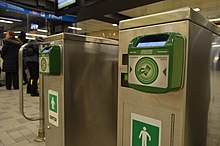Presto card
The Presto card (stylized as PRESTO) is a contactless smart card automated fare collection system used on participating public transit systems in the province of Ontario, Canada, specifically in Greater Toronto, Hamilton, and Ottawa.
A year-long pilot of the system on GO Transit's Richmond Hill line was scheduled to begin in the fourth quarter of 2000, but was delayed to June 2002.
The larger anticipated userbase prompted the MTO to decide on developing a new system, called Presto Next Generation (PNG).
The Auditor General of Ontario criticized this move, suggesting that the base Presto system should have been expanded to accommodate OC Transpo and the Toronto Transit Commission.
[10][12][13] Instead of putting the development Presto Next Generation out to competitive tender, Metrolinx simply increased the size of the original base contract awarded to Accenture in 2006.
[14] The Presto rollout on the TTC's surface transit fleet have been marred with abnormally high failure rates of the readers themselves[15] and cost overruns.
[18] The figures were confirmed by Metrolinx in later reports, stating that they had granted 12 of 26 requests received from various police agencies.
[19] In response to calls for reforming the data sharing system from experts and transit riding advocates, Metrolinx launched a formal review of its privacy policies.
Presto was forced to use its existing software back-end for other municipal transit partners that have completed the roll-out, as the TTC has yet to develop its own dedicated infrastructure to process the larger volume of transactions it typically handles.
[23] The new fare gates suffered from persistent mechanical and software problems, prompting the TTC to suspend the rollout for a month to work with the contractor, Scheidt & Bachmann, to resolve reliability issues.
As of late 2018[update], the TTC Presto system at large continues to experience abnormally high failure rates.
[32] The 2018 Audit Work Plan by the auditor general of Ontario noted that the number of reports of Presto collection machines not functioning properly is likely under-counted and a breakdown in communication between Metrolinx, the TTC, and two of its vendors led to operational issues.
This included a finding that over half the "out-of-service" incidents raised for the fare vending machines on the TTC's new Flexity streetcars are "coin or token box full" errors, the root cause being miscommunication between the TTC and Metrolinx on coin and token collection leading to the vending machines not being emptied frequently enough.
[33] In early 2018, Metrolinx detailed a plan to increase transit ridership by use of a mobile app (available for Android and iOS devices) which it released to the public for testing in beta version in late 2018.
[35][36][37] Presto cards are available to purchase at most Shoppers Drug Mart stores, transit centres in the GTHA and Ottawa, over the phone and online.
[38] Beginning in Stage 3, cardholders will also be able to load passes for up to three transit systems at a time on to their Presto card.
The following transit service providers use Presto: The following transit service providers accept Presto for free transfers but not for purchasing fares: In July 2007, 500 commuters who normally commuted from Meadowvale and Cooksville GO stations in Mississauga to Union Station in downtown Toronto received a free card and tried the system under a trial termed "Launch 1".
[44] Officials decided to test the fare system on Mississauga's neighbourhood shuttle service in Meadowvale and Cooksville that transports passengers to GO Transit.
GO Transit continued its system-wide rollout, with the Lakeshore East, Milton and Georgetown lines coming online at a rate of a few stations a week.
The Toronto Transit Commission added six downtown stations (St. George, Queen's Park, St. Patrick, Dundas, College, Bloor/Yonge) to the Presto system.
[86] The pilot kiosks have since been removed and a widespread rollout of automated reload systems is ongoing throughout GO, TTC, and Union Pearson Express stations.
[87] Stage Four and Presto Next Generation had been criticized for numerous delays with launching OC Transpo service.
Metrolinx set 1 July 2012 as the Presto launch date for Ottawa, but in June 2012, it was postponed to 1 February 2013.
Unlike the Presto card, the Presto ticket is valid only for TTC services; it cannot be used for any other regional service providers or on TTC bus routes operating outside of the City of Toronto, such as those in York Region (north of Steeles Avenue) and Mississauga (west of Pearson Airport).
[103] On most GTHA transit systems, customers also have the option to pay their adult single-ride fares by tapping a contactless credit card, debit card (such as Visa, Mastercard, American Express, or Interac) or a mobile device (mobile phone or watch) on a Presto fare reader when or prior to boarding a transit vehicle (and alighting for GO Transit or UP Express) in addition to being able to use the Presto card.
As of 8 September 2024,[update] open contactless credit and debit card payment options can be used on the following transit service providers:[104][105][106][107][108][109]





